In recent years, there has been a growing interest in sustainable living and eco-friendly practices. Many real estate markets have also seen an increase from homebuyers in their preferences towards properties that are not only stylish and comfortable, but also environmentally responsible. One way to ensure your home meets these standards is by obtaining a green certification.
What is a Green Home Certification?
A green home certification is a formal recognition of a property’s sustainable and environmentally friendly features and practices. It is a stamp of approval that assures potential buyers that the home has been designed and built with a focus on reducing its environmental impact. Obtaining this certification typically involves an evaluation of the home’s energy efficiency, water conservation, indoor air quality, and overall eco-friendly design.
There are various green certification programs available, but one of the most well-known is the Leadership in Energy and Environmental Design (LEED) certification. LEED certification is issued by the U.S. Green Building Council and comes in different levels, ranging from Certified to Platinum, depending on the extent of sustainable features implemented.
Why is Green Certification Worth It?
Energy Efficiency and Cost Savings: According to the U.S. Environmental Protection Agency (EPA), homes with green certifications tend to be significantly more energy-efficient, consuming 20-30% less energy on average. This means lower utility bills for homeowners, and over time, these savings can add up significantly.
Increased Home Value: Research by the National Association of Realtors (NAR) has shown that green-certified homes tend to have higher resale values. In some cases, they can sell for up to 10% more than comparable non-certified homes. This increase in home value is a result of the added appeal and the long-term cost savings associated with sustainable features.
Faster Sales: Green-certified homes also tend to spend less time on the market. According to a study by the Earth Advantage Institute, certified homes sold, on average, 22% faster than non-certified homes. This is likely due to the increased demand for environmentally friendly properties.
Healthier Indoor Environment: Green-certified homes often boast superior indoor air quality and a healthier living environment. Better indoor air quality can reduce respiratory illnesses and allergies, making certified homes more attractive to potential buyers.
Environmental Impact: Sustainable homes have a lower carbon footprint and are less harmful to the environment. According to the U.S. Green Building Council, green homes reduce carbon emissions by up to 34%.
Access to Incentives: Many municipalities and states offer incentives, tax credits, and rebates for green-certified homes. These incentives can help offset some of the costs associated with obtaining certification, further enhancing the value of the investment.
Future-Proofing: As environmental regulations become more stringent, homes with green certifications will be well-prepared for evolving environmental standards. This future-proofing aspect ensures that the property remains attractive and compliant with changing regulations.
Positive PR and Marketing: Green-certified homes are often easier to market, as they align with the values of a growing number of environmentally conscious buyers. Sellers can leverage this marketing advantage to attract a broader pool of interested buyers.
Getting a green certification for your home can lead to reduced energy consumption, cost savings, and increased property value. These tangible advantages may attract buyers, reduce costs, and contribute to a better future for both homeowners and the environment. It’s a win-win for the planet and your pocketbook.



